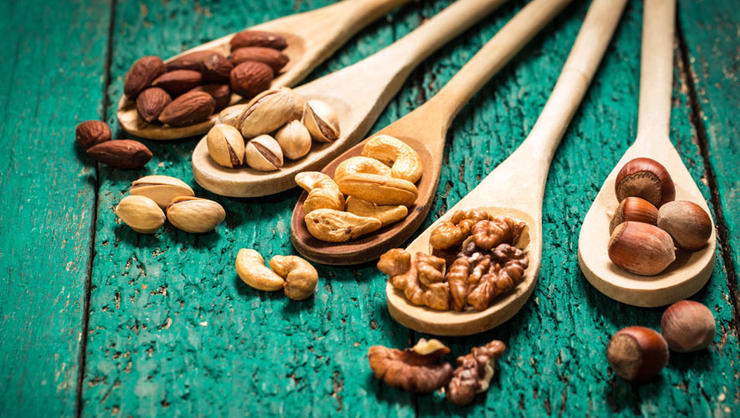
According to Ayurvedic teachings knowing your dosha “that which contaminates” and guna provides you with an understanding of your basic physical and psychological nature, and helps tailor a personal diet and lifestyle to maintain optimum health and peace of mind. Ayurveda teaches that health is maintained by the balancing of the three Doshas, Vatha, Pitta and Kapha. According to ayurveda, the five fundamental elements that make up the universe, space (akasha), air (vayu), fire (agni), water (apu) and earth (prithvi) also make up the human physiology. Vata dosha is made up of space and air. Pitta dosha is a combination of fire and water. Kapha dosha is made up of water and earth. Pitta is increased by foods which are sour and pungent, Kapha is aggravated by milk products, Vata is over-stimulated by beans, dry fruits, astringent and bitter substances.
Fill your stomach with 1/2 food, 1/4 warm water and leave 1/4 empty for digestion. |
There are 10 food combinations that are considered bad by Ayurveda. Some of the immediate consequences of these bad food combinations are digestive un-ease, gas,bloating, stomach ache, nausea, fatigue, and problems with elimination. Long-term food combining can lead to more severe problems like bad breath, dry skin, rashes, chronic inflammation, poor sleep, low energy, and chronic digestion issues.

Fruit after a meal. Take note that fruits don’t combine well with other foods. The reason is that fruit contains simple sugars that require no digestion. Thus, they will not stay for a long time in the stomach. Other foods, such as foods rich in fat, protein and starch, will stay in the stomach for a longer period of time because they require more digestion. If you consume fruit after meal, the fruit sugar will stay for too long in the stomach and ferment.

Lasagna or Grilled Cheese Sandwich. Protein-starch combos inhibit salivary digestion of starch. Protein and starches need different enzymes and different levels of acidity to be digested. When eaten together, your body is forced to make a choice to digest protein but not starches. In such a case, undigested starchy food undergoes fermentation and decompose and overtime lead to poisonous end-products. Supposedly, adding greens to hard-to-digest cheesy dishes makes them easier for the stomach.
Cheese and meat omelet. In general protein/protein combinations are not recommended. Although every food contains some protein, those regarded as protein concentrated foods demands the longest digestive time. They are held in stomach for some hours until the gastric juices has performed its task. This may vary from 2 hrs to 6 hrs, depending upon the complexity of the protein in the food. One single concentrated protein per meal is easier to digest and won’t require as much energy. Go for veggie omelet instead.
Tomato and cheese pasta sauce. Tomatoes are considered acidic and are not advised to be mixed with starchy carbs such as pasta. Food combining theory recommends to avoid mixing carbohydrates with acids. Adding dairy to this already difficult combo turns it into a recipe for digestive problems and after-meal fatigue since your body will require a ton of energy to digest this meal. Have pasta with pesto and grilled veggies instead!
Cereal with milk and orange juice. Acids in orange juice or any acid fruits destroy the enzyme that is responsible for digesting starches present in cereal. Also, acidic fruits or juices can curdle milk and turn it into a heavy mucus-forming substance. To keep your breakfast healthy, have fruit or orange juice 30 min before the cereals.
Beans and cheese. Dairy protein and beans eaten with a hearty serving of guacamole and hot sauce, is almost guaranteed to lead to gas and bloating. It is not the beans on their own that cause it, but the combination as a whole. Try skipping cheese and tomatoes if you have a weak digestion or working on detoxifying your body.
Melon and Prosciutto. Melons should be eaten alone or left alone. The same rule goes for all high sugar fruits. In general, it is preferred to eat fruits separately from proteins or starches, especially if you are looking for a quick energy boost from a fruit.
Bananas and milk. Bananas are heating while milk is cooling. Further, bananas become sour as they break down. It is said to create heaviness in the body and slow down the mind. Their opposing qualities tend to smother the digestive fire and can disrupt the balance of intestinal flora, which results in the creation of toxins. If you are a fan of milk-based banana smoothies make sure that banana is very ripe and add cardamom and nutmeg to stimulate digestion.
Yogurt with sour fruit. Ayurveda and food combining theory, don’t advise mixing any sour fruits with dairy as it can diminish digestive fire, change the intestinal flora, produce toxins and cause sinus congestion, cold, cough and allergies. Ayurveda suggests avoiding congestive and digestive fire dampening foods like cold yogurt mixed with fruits. However, if you can’t resist the temptation of a yogurt parfait, there are ways to make it more digestion friendly. First of all, go for a room temperature natural unflavored yogurt. Secondly, mix a little bit of honey, cinnamon, and raisins instead of sour berries.
Lemon Dressing on Cucumber and Tomato Salad – Vegetables like potatoes, chillies, eggplant, and tomatoes are not supposed to be combined with cucumbers. While lemon does not go well with either.
Many a times its not an allergy to particular food item but a wrong combination of food, that is to blame. If you follow simple food combination rules for 2 weeks and let your digestive system rest, your digestion will be a lot more efficient and stronger. You will experience a flat belly.
Embracing the wisdom of food combining slowly will help you to cultivate a refined awareness around how the dietary choices affect you. This heightened sensitivity can be an invaluable asset, regardless of how quickly you are able to replace improper food combinations with more supportive ones.